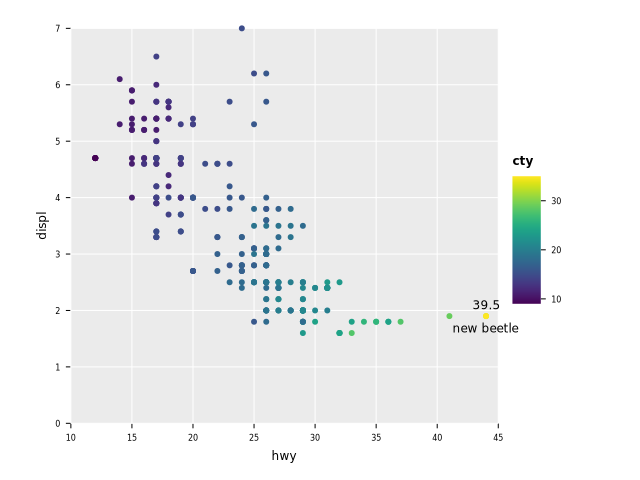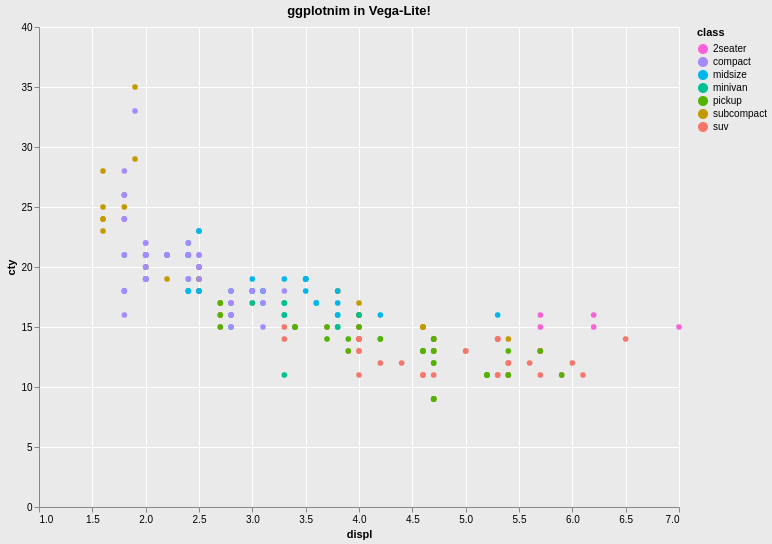This package, as the name suggests, will become a “sort of” port of ggplot2 for Nim.
It is based on the ginger package.
If you’re unfamiliar with the Grammar of Graphics to create plots, one
of the best resources is probably Hadley Wickham’s book on ggplot2,
for which also an online version exists at:
https://ggplot2-book.org/
In general this library tries (and will continue to do so) to stay
mostly compliant with the ggplot2 syntax. So searching for a
solution in ggplot2 should hopefully be applicable to this (unless
the feature isn’t implemented yet of course).
The dataframe implementation that was part of this library until
version v0.4.0 is now in its own repository under the name of
Datamancer:
https://github.com/SciNim/Datamancer
This library imports and exports Datamancer, as such you don’t need to
change any code, even if you only imported ggplotnim to access the dataframe.
For a more nimish approach, check out the recipes, which should give you examples for typical use cases and things I encountered and the solutions I found. Please feel free to add examples to this file to help other people!
Note that all recipes shown there are part of the test suite. So it’s guaranteed that the plots shown there for a given version actually produce the shown result!
The documentation is found at:
https://vindaar.github.io/ggplotnim
Installation should be just a
nimble install ggplotnimaway. Maybe consider installing the #head, since new version
probably won’t be released after every change, due to rapid
development still ongoing.
Since this library is written from scratch there is only a single
external dependency, which is cairo.
Using ggplotnim on Windows is made slightly more problematic,
because of the default cairo backend. Installing cairo on Windows
is not as straightforward as on Linux or OSX.
There are multiple options, from most complicated to easiest:
- installing a program, which also uses
cairoon Windows, for exampleemacsand adding said program to Windows’ PATH. Some instructions here: https://gist.github.com/Vindaar/6cb4e93baff3e1ab88a7ab7ed1ae5686 - using @pietroppeter’s approach to only install the shared libraries that are actually required, see here: https://gist.github.com/pietroppeter/80266c634b22b3861273089dab3e1af2
- or to thank @preshing’s work and use his standalone single DLL for
cairoon windows: https://github.com/preshing/cairo-windows/ See how it’s used in the Github Actions workflow for Windows here: https://github.com/Vindaar/ggplotnim/blob/master/.github/workflows/ci.yml#L61-L64
Personally I would recommend the last option. Note however that the
standalone DLL is called cairo.dll, but ggplotnim expects the name
libcairo-2.dll. I would recommend to put the DLL in some sane place
and adding that location to your Windows PATH variable:
Simple text only instructions on how to do that:
Winkey- search for “path”
- click on “edit system environment variables”
- click on “Environment Variables” in the bottom right corner
- under “System variables” select “PATH” and click edit
- click “New” and add the full path to your installation location of choice that contains the now called
libcairo-2.dll
After saving those changes and restarting PowerShell / the command prompt everything should work.
Geoms:
geom_pointgeom_linegeom_histogramgeom_freqpolygeom_bargeom_errorbargeom_linerangegeom_tilegeom_rastergeom_textgeom_ridgeline- soon:
geom_density
Facets:
facet_wrap
Scales:
- size (both for discrete and continuous data)
- color (both for discrete and continuous data)
- shape (multiple shapes for lines and points)
Consider looking at the recipes in addition to the below to get a fuller picture!
The following is a short example from the recipe section that shows multiple features:
- parsing CSV files to a DF
- performing DF operations using formulas (
f{}syntax) - general
ggplotfunctionality - composing multiple geoms to annotate specific datapoints
import ggplotnim
let df = toDf(readCsv("data/mpg.csv"))
let dfMax = df.mutate(f{"mpgMean" ~ (`cty` + `hwy`) / 2.0})
.arrange("mpgMean")
.tail(1)
ggplot(df, aes("hwy", "displ")) +
geom_point(aes(color = "cty")) + # set point specific color mapping
# Add the annotation for the car model below the point
geom_text(data = dfMax,
aes = aes(y = f{c"displ" - 0.2},
text = "model")) +
# and add another annotation of the mean mpg above the point
geom_text(data = dfMax,
aes = aes(y = f{c"displ" + 0.2},
text = "mpgMean")) +
theme_opaque() +
ggsave("media/recipes/rAnnotateMaxValues.png")From the beginning one of my goals for this library was to provide not only a Cairo backend, but also to support Vega-Lite (or possibly Vega) as a backend. To share plots and data online (and possibly add support for interactive features) is much easier in such a way.
An experimental version is implemented in ggplot_vega.nim, which provides most functionality of the native backend, with the exception of support for facetted plots.
See the full example in the recipe here.
Creating a vega plot is done by also importing the ggplot_vega
submodule and then just replacing a ggsave call by a ggvega call:
import ggplotnim
import ggplotnim/ggplot_vega
let mpg = toDf(readCsv("data/mpg.csv"))
ggplot(mpg, aes(x = "displ", y = "cty", color = "class")) +
geom_point() +
ggtitle("ggplotnim in Vega-Lite!") +
ggvega("media/recipes/rSimpleVegaLite.html") # w/o arg creates a `/tmp/vega_lite_plot.html`This recipe gives us the following plot:
To view it as an interactive plot in the Vega viewer, click here.



